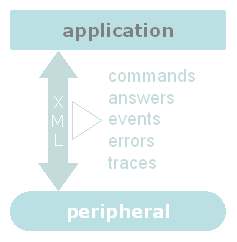|
|
The Xpeak specifications define XML messages to be interchanged between Applications and different Xpeak components (Servers, Devices and Services). The messages can be relative to:
CommandsThe commands can be sent directly to a Service (for example, turning on a led) or equally to a Device (activate traces for the whole Device) and even to the Server itself (obtain the Devices and Services). Most of the commands will generate the sending of a synchronised answer and some of them will cause an event to be sent later. AnswersThe answers will always be sent as a result of a command being received. EventsSome commands will cause an event to be sent. For example, the ejection of a card will send an event indicating whether the card was taken by the client or whether there was an error such as, for example, timeout expired. ErrorsThe Services can generate asynchronous error messages allowing the Application or net control software to monitor them. TracesThe traces can be activated for a specific Device or Service. The way in which the information is processed will be the responsibility of the Application. |


